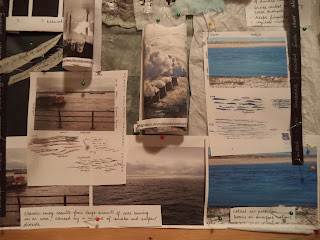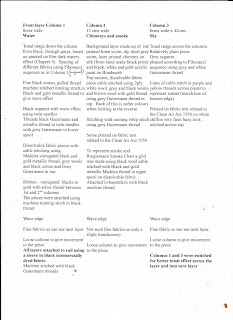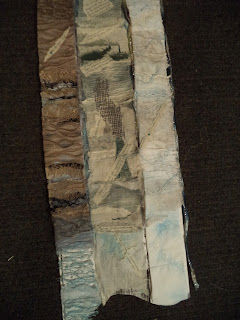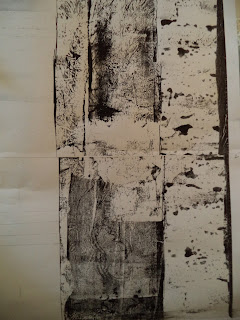Jae Maries
Barbara Lee Smith
Sandra Meech
Alison Holt & Frank Green
Jae Maries
Jae Maries is a member of the 62 group of textile artists having recently completed 4 years as chair (2009 – 2013). She started her career with a BA Hons degree in Fine Art at Reading University followed by a Diploma in Creative Embroidery (Distinction) at Brighton University.
I researched the artist on the website http://www.jaemaries.com/
Jae Maries is an oil painter and textile artist and tutor who has exhibited widely with many commissions of her work. She tries not to be influenced by other artists but admires Picasso, Matisse and Antoni Tapies.
Her inspiration comes from the world around her, using sketch books as a starting point. She also enjoys interpreting feelings, actions or visual stimuli in an abstract way and is currently basing her work on diary sketch book entries.
Her textile work involves using unbleached calico. Her fabrics are always painted or dyed, often applying Sericol screen printing inks after stitching and manipulating the fabric. The dyes are applied with a palette knife or sponge roller. These fabrics are then applied to the oil painted surfaces which have been stitched before the application of paint.
Jae uses a very restricted palette and selects colours that will underline the feelings and ideas that she wants to express in a piece of work. She mostly works in hand stitch using machine stitch to join pieces. Does not like using metallic threads!
In her book
'Contrasting Elements' she shows through simple instructions how
dynamism can be brought to work using contrasts in colour, materials
and imagery by translating paper to fabric and stitch using contrasts
in painting, cutting, knotting, knitting, weaving, wrapping and
stitching.
I particularly like
'Turbulent seas' (2014) shown on Jae Marie's website relevant to the
theme of water but with an abstract arrangement and minimal stitch.
Barbara Lee Smith
Barbara Lee Smith is an American artist and worker in textiles and amongst her compliments for her work she was made an honorary member of the Embroiderers' Guild, UK. She started her career as a textile artist later in life following a fine arts course leading to an MFA in 1978 with honours. Throughout her life she has had a goal to help the field of textiles be recognized as a major art form and for artists to have recognition when working with fibre as their primary medium.
I
researched the artist on the website http://www.barbaraleesmith.com/
Her influence is 'rhythms of nature' and the importance to sustain it for the future, in particular expressing in her large art pieces non-representational images of the land, sea and sky.
She works usually using
an industrial grade polyester non-woven fabric which looks like
paper. She paints using Daniel Smith acrylics and Golden Gesso and
silk paint pigments for light-fastness.
She uses a three stage
process of layering, painting, collage and line running machine
stitch representing a contour effect.
I rather like this idea
of making a topographical image on the work (the geographer in me!).
There is a very useful
website which answers many questions about this artists work
I have chosen a piece
from this second website showing water and the contour stitching.
Barbara Lee Smith – Marshland Spring (detail)
Sandra Meech
Sandra Meech is author of several books but the one I found particularly useful related to this course is 'Contemporary Quilts: design, surface and stitch' published by Batsford (2003) 2005
It
seemed to cover many aspects of the course from inspiration sources
uses of paper, paint and pattern, collage, cloth, dyes, fabric paints
and sticks, plastics, elements of design, colour theory, stitch
techniques and assembly.
Information about this artist can be found at
and
She is originally from Canada, inspired by nature and a sense of place. She uses photo imagery, drawing and collage as starting points.
In the 1990s she
acquired City and Guild qualifications in Stitched textiles,
Patchwork and quilting. She has acquired many international awards
and work is exhibited in public and private collections, and travels
worldwide teaching classes in creativity, art and design with mixed
media.
I would like to highlight her work on the Somerset Levels, (she no longer lives in Canada!) which can be found on the second website mentioned above of which this is one image. It includes monoprints and collographs as well as machine stitching in running stitch to create textured quilted effects.
Alison Holt & Frank Green
One
is a textile artist the other a water colour artist. Both I have
managed to see their work and hear them speaking. Alison Holt
visited our Embroiderers' Guild a few years ago and Frank Green was a
recent speaker at a local art event in Llandudno. Both are extremely
talented in producing realistic images which I wished to mention although the brief for Module 6 was not to do so.
Information
can be found about Alison Holt at
Alison
Holt is author of 'Machine embroidered seascapes' Search Press Ltd ,
2012 and appropriate topic.
In
the book she gives clear instructions of how to use inspiration
sources, sea and sky in this instance, using planning and
composition, painting on fabric, selecting and using threads for
tonal shades and machine stitch to produce beautifully layered work.
I
love her work and was so happy to eventually get her book. Here is a
copy of the book cover which also shows one of her seascapes.
Frank
Green is a water colour artist and was instrumental in producing
several paintings of Liverpool streets, capturing their characters
even before some were demolished (another conservation or preservation theme). He was raised in Walton and
educated at Florence Melly School and Liverpool Art College.
Information
can be found about Frank Green including a fascinating video where he talks about his background to becoming an artist, at
I
purchased a short book of the architects of Liverpool by Frank Green
in which there are many of his paintings and sketches of Liverpool, but I
particularly like some of his paintings showing water and sky. I
managed to purchase some of his cards of art work which portray areas
of the waterfront in Liverpool, through the seasons and showing the
difference between night and day. (See also Chapter 1 of Module 6
where there are photos from his demonstration of a seascape,
Penmaenmawr, North Wales).
Looking at these cards I noticed how well the marks used in the water were visible and would make interesting stitched fabrics.


















































